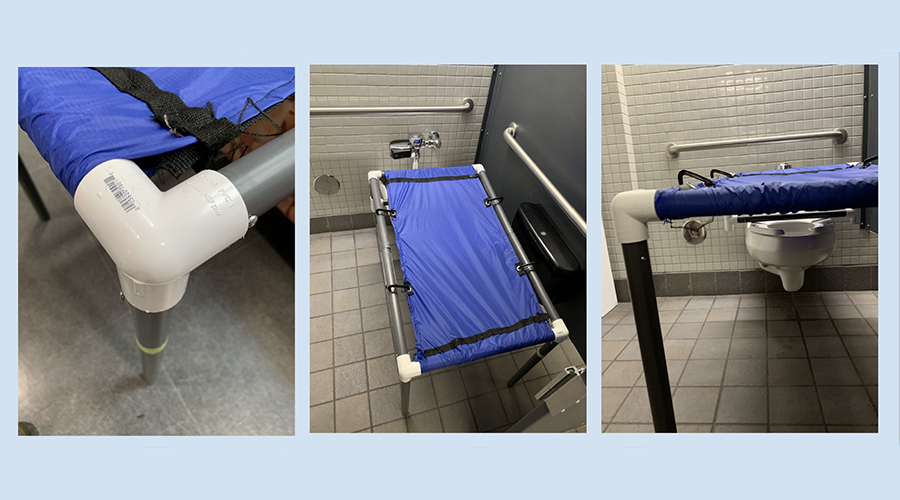DuracotA portable changing table for a young person with cerebral palsy
As a part of the Design Thinking & Communication course, a team of four first-year engineering students was tasked with designing a collapsible changing table that facilitates diaper changing for a 9-year old with cerebral palsy within the privacy of a handicap stall in public restrooms.
The team members were Tony Bayvas, Matthew Ley, Kevin Mendoza Tudares, and Samuel Petralia. They were guided on their learning journey by Northwestern faculty members John Lake and Laura Pigozzi.
The most fulfilling part of this project was designing a device that improved the quality of life for Anne and her son. While doing this, we realized that there is an untapped market for products that can benefit people with cerebral palsy in their daily lives.
Problem
The project partner, Anne, has a son with cerebral palsy. Due to this condition, her son has limited control of his bladder and bowel movements, so he currently wears diapers. At home, Anne typically changes her son’s diaper on his bed. However, sometimes Anne needs to change her son’s diaper when they are in public spaces. As her son has grown older, he has become too large and heavy for the conventional changing tables found in public restrooms. Instead, Anne has opted to lie her son down on a cloth on the bathroom floor, which is a method of changing she finds to be unsanitary and unpleasant. Meanwhile, Anne experiences significant physical difficulty lifting her son from his stroller and placing him on the floor. Anne requested asked the team of students to design a safe solution that addressed this lack of an effective changing surface for her son in public restrooms while meeting three needs: compactable, portable, and subtle in its design aesthetic.
The team added several constraints for the design in order to meet those needs:
- To ensure safety, the design must hold 150 lbs, which is twice the current weight of Anne’s son.
- To ensure that Anne’s son can be comfortably changed, the design cannot make more than a 5-degree angle with the horizontal and the changing surface should be approximately 20 inches by 32 inches by 2 inches order to provide sufficient room.
- The design must fit on the stroller that Anne uses to push her son when they are in public (and the design should not have to be carried personally by Anne).
- The design must weigh less than ten pounds so that Anne will not experience strain lifting it or carrying it using the stroller throughout the day.
- The design must not be excessively uncomfortable for the users (minimizing sharp edges and irritating materials).
- The design must be at a height that is comfortable for Anne to use, which they determined to be between 22 inches and 26 inches, approximately.
- Because the design will be stored on a stroller, it must be able to be stored in a way that does not interfere with using the stroller.
Solution
The team’s final design, the DuraCot, features a nylon fabric work surface (with durable nylon stitching and reinforced grommets) attached to a collapsible and rigid PVC frame that uses the toilet in the restroom’s handicap stall as a support. The DuraCot serves as a portable changing surface that Anne can take along with her and her son when leaving the house using two transport bundles
The DuraCot is portable thanks to a collapsible frame made out of lightweight PVC and nylon, which reduces the weight of the device and makes it easier to transport. The DuraCot’s simple frame design held together by shock cord guides the user through constructing, collapsing and storing the device. The DuraCot includes a hinge that allows it to fold in half.
Easily able to support up to 150 lbs, the DuraCot works in a fashion similar to a typical cot. The caretaker inserts the PVC pipes into their joints using the shock cord running through the joints as a guide. Next, the user pushes the hinges down while setting up the table, which tightens the nylon fabric and minimizes sag. The back legs and crossbar of the design are designed specifically to rest on the toilet that will be found in an ADA-compliant handicap stall.
The team conducted testing and found that the DuraCot was intuitive and straightforward to assemble or disassemble within a handicap stall.
Development Process
Early in the design process, the team conducted thorough research into the problem. First, they identified products already on the market intended as adult changing tables. They found an existing product that was not portable and cost more than three thousand dollars. Second, they investigated products such as folding chairs, tables, and a collapsible stretcher, which all succeed in suspending and supporting a load above the ground while being portable. The features and design concepts from those products proved important during the stages of the development process in which the team brainstormed and generated alternatives.
The team also conducted interviews with Anne and observed her son at home. They were given a tour of the amenities that had been built into their house to make it more accessible and shown the equipment (such as walking aids and a positioning wheelchair) used by Anne’s son. Anne also demonstrated how she would normally change a diaper (with her son clothed during the demonstration).
The team conducted user testing with Anne and her son and prepared three mockups for that testing: the Port-a-Puzzle; the Foldable Stretcher; and the T-Support. Each mockup was used in several testing procedures to facilitate discussion about the key needs for the final design.
Current Status
The DuraCot is currently being used by Anne for her son and the team is planning to pursue a patent.
Faculty AdvisorsJohn Lake, Laura Pigozzi
ProgramDesign Thinking and Communication (DTC)



